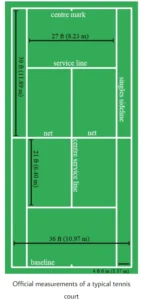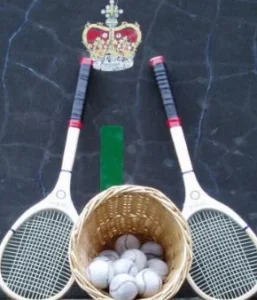Are you interested in picking up tennis? Alternatively, would you like to understand what’s happening when you watch tennis on TV or at a tournament? It goes without saying that understanding tennis regulations is necessary to fully comprehend the game. At first, though, they could be a little difficult to recall, but we’ll do our best to make sure you understand every small detail. To find out more about the official tennis rules that are accepted by the majority of tennis organizations, continue reading.
Tennis Regulations
First of all, tennis rules for singles and doubles matches differ, while generally being identical. Before delving into that topic, let us recap some of the fundamental tennis laws and guidelines that govern the game before learning how to play singles and doubles.

Tennis Rules in General
- – Play cannot begin until the ball lands inside the lines; if a player strikes the ball outside the lines, they forfeit the point.
- – Teams or players aren’t allowed to cross over to the other team’s side or touch the net or posts.
- – Teams and players are not allowed to carry the ball or use racquets to catch it.
- – A player cannot hit the ball twice.
- – Before returning the ball, players must wait for it to cross the net.
- – A player forfeits the point if they fail to return a live ball before it bounces twice.
- – A penalty is called whenever the ball strikes or comes into contact with a player.
- – There is a penalty for dropping the racket or using foul language.
- – Any ball that bounces on the boundary lines is regarded as excellent.
- – A serve cannot be returned by the receiving player until it has bounced.
Tools
Racquet:
The components of a racquet include a handle, a frame, and strings that are woven together in a crosshatch pattern. A racquet’s frame should not be longer than 32 inches, its handle should not be wider than 12.5 inches, and its surface should not be wider than 11.5 inches or longer than 15.5 inches overall. Additionally, nothing may be placed on the racquet other than wear-and-tear and vibration-reducing devices.
Ball:
A tennis ball has a diameter of 2-1/2 to 2-5/8 inches and weighs between 2 and 2-1/16 ounces. It is colored white or yellow for competitions. Aside from the ball’s elasticity, the required criteria also dictate its uniform exterior surface.
Rating
The smallest unit of measurement is a point. In the Love(0)-15-30-40-game, points increase.
- Games: Each game consists of four points, and a player wins if they achieve four points with a minimum two-point edge.
- Sets: The person or team that completes six games first and has at least a two-point advantage wins the set. Each set consists of six games.
- Advantage Set: A player or team can only win a set with a two-game lead if the game score reaches 6-6 and the advantage set rules are applied.
- Matches: Best of three or best of five sets are the typical formats for matches.
- Deuce: When a score of 40-40 is obtained, this happens. A player or team needs to win two straight points to win the game. A player gains an advantage after winning one point, but the score goes back to deuce if they lose the subsequent point.
- Tie-break game: Players must play a tie-break game to determine who wins the set if the game score reaches 6–6 and the tie-break set rules are applied. A person or team needs to score seven points with a two-point advantage to win in a tie-break game. In the event of a tie-break, player 1 serves first, followed by player 2 for the next two points, player 1 for the following two points, and so on.
For a more thorough explanation of the terminology used in tennis, including terms not included in the official rules, you may find it here.

What Do the Lines Signify?
- Baseline: The lines that define the lengthwise bounds of play are the baselines, and they are located on either end of the court. A player serves behind them as well.
- Center Mark: The tennis court’s two halves are identified by their respective centers. It mostly aids in serving by indicating to a player where they should stand before serving.
- Center Line: On each side of the court, the center line separates the two service boxes into a left and a right service box. Serving from the line is seen as good.
- Net: The posts are 3 feet outside the court on either side, making the middle of the net 3 feet tall. The net is 3 feet and 6 inches high where the posts are located. Any ball that strikes the net cord and falls to the other side is deemed good, with the exception of serves, which permit retries or lets. Hitting the ball into the net is regarded as an out.
- Service Line: This line indicates the length of the service box and divides the forecourt from the back court.
- Singles Sideline: The singles sideline, which is the innermost line that runs lengthwise, establishes the width of the service box and the boundaries of play during singles matches.
- Doubles Sideline: Used exclusively in doubles matches, the doubles sideline is the outermost line that runs lengthwise.
Who Takes Up Position One?
Who serves first, either a player or a team, is decided by a coin flip or a racket spin. The person or team that called the proper number gets to choose who serves first. The player or team who made the incorrect call determines who gets to play on which side of the court first.
Gather Rally
Following the serve, players trade shots until one of them makes a mistake and the other team loses the point. This is known as a rally. A shot that stays inside the lines is deemed good and helps the rally to progress. You will need to be able to rally regularly if you want to learn how to play tennis.

Selecting and Serving Appetizers
A foot error occurs when a player crosses the center line or enters the court before making contact with the ball. The serve is lost as a result of this.
Proper serve
The proper serve is when a player starts a game by serving from the right side of the court with the intention of serving the ball into the diagonal service box. Play can resume if the serve lands in the appropriate service box. For the following point, the server flips to serve on the left, and so on, continuing in this manner until the game is won.
At the start of every game, players serve from the right side of the court, attempting to place their shot into the diagonal service box on the other side.
- First Service: There are two opportunities for the server to place the ball inside the service box. The initial effort is referred to as the first service. The second service is provided in case the first one fails.
- Second Service: The term “second service” refers to the second effort. The point is forfeited if the second service is not provided successfully.
- Allow me to clarify that a player who serves but the ball strikes the net cord before landing in the proper service box is awarded a let, which is a second opportunity. You are permitted an endless number of lets, however infrequently.
- Order of Service: Whoever wins the
- toss serves first (the winning team selects the person who serves). Every game in a singles match, competitors switch between serving and receiving. In doubles matches, teams take turns serving and receiving throughout each game. Before the cycle restarts, every player on a team gets a turn serving.
- Switching Sides: For each game with an odd number, players or teams trade sides (thus, games 3, 5, 7 etc.).
Tennis Rules: Singles vs. Doubles
The serving order and court dimensions are the primary differences between the tennis regulations for singles and doubles matches. The regulations of doubles tennis are essentially the same as those of singles matches, with the exception of adding space for an additional player on each side of the court. Here is the proper way to play tennis for both singles and doubles games.
Tennis Singles Rules Court Dimensions
A singles court is 27 feet broad by 78 feet long and uses the innermost sideline.
Getting the Order in
Who serves first is decided by the player who wins the toss. For the length of the first game, the person serving first serves. The player who received the least amount of money will serve as the next server after the game and do so for the length of the second game. In each game with an odd number, players exchange places on the court.
Order of Tie-Break Serving
In the event that a score of 6–6 is reached and tie-break regulations are used, the winner of the set is decided by a tie-break game. In a tie-break match, winning the set is determined by reaching 7 points first with a lead of at least 2. The player who generally serves after 6–6, or 12 games, is the one who serves first.
In case of a tie-break, the following is the serving order:
- – Point 1: Player A
- – Point 2: Player B
- – Point 3: Player B
- – Point 4: Player A
- – Point 5: Player A
- – Point 6: Player B
- – Point 7: Player B
- – Point 8: Player A
- – Point 9: Player A
Complementary Structure
Although some men’s singles tournaments go to a best-of-five format, a singles match typically consists of three sets. Actually, everything is determined by the players’ inclinations regarding the tournament’s regulations.

Tennis Doubles Rules Court Dimensions
A doubles court is 36 feet wide and 78 feet long, with the outermost sideline being used.
Getting the Order in
Whichever side wins the toss determines who gets to serve first, and that team choose which member will serve first among themselves. For the length of the first game, the person serving first serves. That team will select the next server after the game, and they will serve for the length of the following game. Teams alternate sides of the court for each odd-numbered game. The player from the first team who hasn’t served yet must now serve, followed by the player from the second team who hasn’t served yet, and so on.
Order of Tie-Break Serving
In case of a tie-break, the following is the serving order:
- – Point 1: Player A
- – Point 2: Player X
- – Point 3: Player X
- – Point 4: Player B
- – Point 5: Player B
- – Point 6: Player Y
- – Point 7: Player Y
- – Point 8: Player A
- – Point 9: Player A
Complementary Match Structure
The best-of-five format is frequently used in doubles matches.
